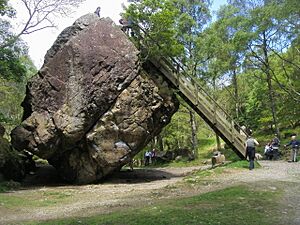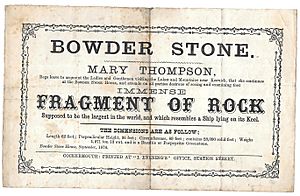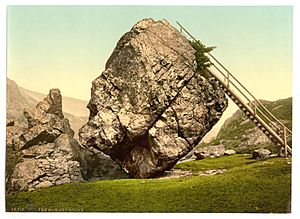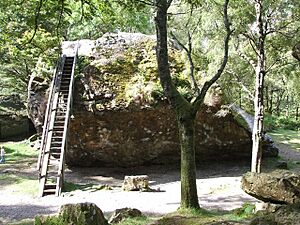Bowder Stone facts for kids
The Bowder Stone is a giant rock in Borrowdale, Cumbria, England. It's a huge piece of andesite lava that broke off a nearby cliff called Bowder Crag. This happened a very long time ago, between 13,500 and 10,000 years ago!
Imagine a rock as heavy as 2,000 cars – that's about how much the Bowder Stone weighs! It stands about 30 feet (9 meters) tall, is 50 feet (15 meters) wide, and measures 90 feet (27 meters) around. Since at least 1890, there has been a staircase that lets visitors climb right to the top.
Contents
What's in a Name? The Bowder Stone's Story
The name "Bowder Stone" might just come from an old local word for "boulder." But there's a more exciting story too! Some people believe the name comes from Baldr, a famous god from Norse mythology. Baldr was the son of Odin, a very important god.
Other old names for the stone include "The Bowdar Stone" and "Powder or Bounder Stone." In 1772, a writer named William Gilpin called it the "Boother-stone." He thought it looked like it was created on its own, not broken off a mountain.
Exploring the History of the Bowder Stone
The Legend of Baldr
As we mentioned, many people connect the Bowder Stone's name to the Norse god Baldr. In Norse myths, Baldr was known for being killed by an arrow or spear made of mistletoe, thanks to the trickster god Loki.
Some say that one side of the Bowder Stone looks like Baldr's face. There was even a small hole on what would be his head. People believed this was where the weapon pierced him in the myth. Old photos show a clear chin and lips on the stone. Some people even see a second face! German miners came to Borrowdale in the 1500s. They worked in the copper mines and might have brought the legends of Baldr with them.
Mr. Pocklington's Big Idea
Many people loved visiting the Bowder Stone, but a man named Joseph Pocklington was the first to make it a real visitor attraction. In 1798, he bought the land around the stone. He put up fences, cleared away smaller rocks, and even built a small house called "Bowderstone Cottage." This cottage was for a guide who would help visitors.
Joseph Pocklington also built a ladder so people could easily climb to the top. From the top, visitors could enjoy amazing views of the area. He also built a small chapel or "hermitage" nearby.
During his work, Joseph found a natural hollow space under the huge boulder. He had a small hole drilled through the stone's base. This created a special spot where visitors could crawl through. They could even shake hands with the guide, or another visitor, from the other side of the stone for "good luck"!
At first, Joseph Pocklington brought his friends to see the stone. Later, he opened it to everyone. Many travelers came, guided by the person he hired. After Joseph died in 1817, the Bowder Stone was sold. But it stayed open to visitors. Guides continued to help people explore the stone. Mary Carradus was a guide in the 1830s, and her daughter, Mary Thompson, guided visitors for over 25 years!
A gate was put at the bottom of the ladder. This made sure visitors paid a small fee to climb up. Guides were very good at their job. One person even wrote that the guide "makes money out of the stone watching for tourists like a spider." The top of the stone had a seat for two people and standing room for six. The Pepper family were the last to live at Bowder Stone Cottage. They kept a guest book that showed many famous people visited, including politicians, students, and professors.
The National Trust: Protecting the Stone
Today, the National Trust looks after the Bowder Stone. This organization protects important historic places and natural beauty spots. Some things have changed since Joseph Pocklington's time. You can no longer crawl under the stone. Also, you can't buy snacks or souvenirs right at the site anymore.
However, Joseph's chapel and the Borrowdale Cottage have been fixed up. They are now used as "bothies" (simple shelters) for climbers. The ladder to the top of the stone is still there. Postcards show that at least six different ladders have been built over the years! There's a car park nearby, and it's about a 15-minute walk to reach the Bowder Stone. There's also a bus stop close to the path.
Bowder Stone Cottage and the Hermitage
For a while, Bowder Stone Cottage was a tea room and a shop. It sold souvenirs like special postcards and small items with pictures of the Bowder Stone. These included penknives, boxes, and glasses cases.
By the 1960s, the cottage was falling apart. After the National Trust bought the site, they rented it to the Northumbrian Mountaineering Club. This club fixed up the cottage, adding electricity and running water. The mountaineering club also rents the old Hermitage (chapel) from the National Trust.





